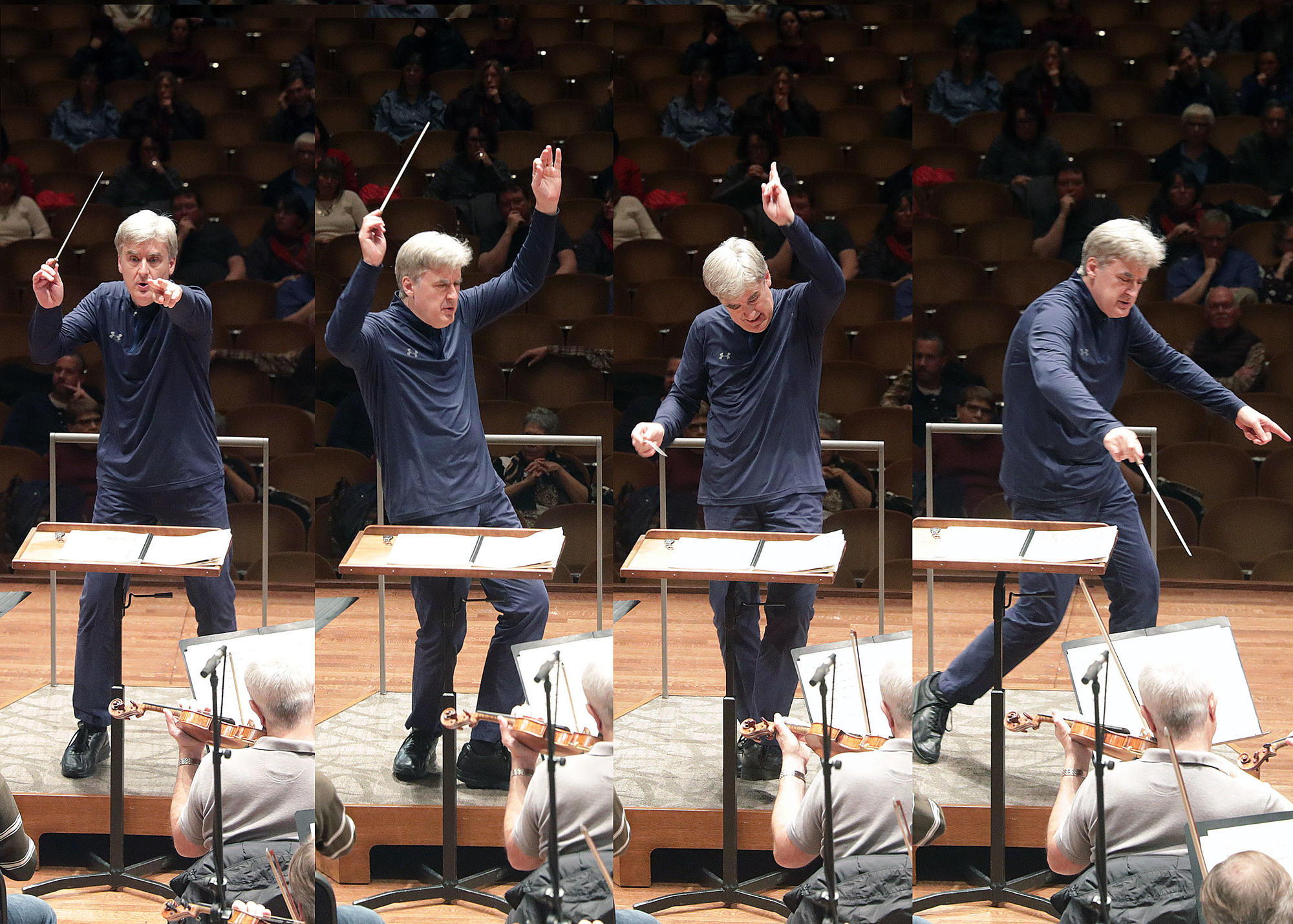Pacing the square podium as if it is a short runway, Dausgaard springs from his haunches, his arms flying and baton whipping the air, his eyes darting from strings to percussion. In one passage, he looks like he’s toiling over an ironing board — his way of eliciting a gluey, grinding effect from the strings. Rite of Spring is all about pagan rituals, and Maestro Dausgaard is ever the whirling wizard.
“I have to feel the music from the bottom of my feet to the ends of my hair,” Dausgaard says. By all appearances, that’s exactly what happens when he takes the stage at Benaroya Hall.
Born in Copenhagen in 1963, Dausgaard started his musical career as a kid playing guitar in a rock band. (It wasn’t until the band landed a Danish TV gig that the members realized they hadn’t settled on a name.)
Dausgaard has been principal guest conductor for the Seattle Symphony Orchestra (SSO) since 2014, and first wowed Seattle audiences with his performances of Mahler and Nielsen symphonies. He succeeded Ludovic Morlot as music director, beginning with the 2019-20 season, and now jets back and forth to Europe, as chief conductor of the BBC Scottish Symphony and the Swedish Chamber Orchestra, in addition to his duties here.
Unlike his two predecessors, Dausgaard is ultraphysical. Morlot was tight and contained on the podium; Gerard Schwarz, SSO’s music director for 26 years before Morlot, had a more formal style, with symmetrical, wide gestures.
“Every conductor is a little bit different,” says principal oboist Mary Lynch. “I don’t think that more motion necessarily leads to more effective, clearer results. You learn how to read every individual,” Lynch adds, noting that many conductors perform with the orchestra each season.
“Some conductors are extremely physical, and some conduct with their eyes only,” says first violinist Mikhail Shmidt. “There’s this kind of magic of different qualities and different ways of this amazing communication between conductor and orchestra musicians.”
As a “language,” conducting is globally understood, but body movement, gestures and expressions specific to a personality imbue it with different “accents,” depending on who’s at the podium.
Video: Thomas Dausgaard conducts an excerpt of "Rite of Spring"
The orchestra conductor wasn’t always the focus of the concert hall. Before the early 1820s, a Mozart symphony would be led by a concertmaster, a member who gave time cues but who also played along. When composers like Stravinsky, Mahler and Ravel started producing complex scores that called for large orchestras, it was hard to keep all the players together across the expanse of the concert stage. Someone had to become maître, the maestro and interpreter.
In America, conductors became celebrities, thanks in part to the masterful hands and tuxedo tails of Leopold Stokowski, who led the musical proceedings in Disney’s Fantasia (1940). In the 1950s, Leonard Bernstein brought more attention and panache to conducting with his series of televised Young People’s Concerts. Now conductors are prestigious cultural figures, and audiences bring theatrical expectations to concerts.
But despite the prestige and applause, most of the conductor’s life is in solitary study of the score.
“That is a lonely process between you and the pages,” Dausgaard says.
Before the first rehearsal, he must know every note and rest, marking the score for entrances, phrasing, dynamics. Only then is he ready to meet the musicians.
“I try to communicate the essence of the music that I’ve been studying,” Dausgaard says, “which hopefully has become a part of me.”
Violinist Shmidt says Dausgaard’s behind-the-scenes preparation is evident. “It’s so much work and research and thinking and rethinking,” he says. “Every time he is in front of our orchestra he goes to the roots of every piece he’s conducting.”
As rehearsal time is limited, every musician must be as prepared as the conductor. Many of them have played a particular work more times than the conductor. SSO musicians are world class; they can literally play any score. But they also have to learn Dausgaard’s personal interpretation and cues.
“I communicate [the score] in many different kinds of ways,” explains Dausgaard. “One is a very coded language we have, which is about breathing — which we formalize in certain patterns.”
Video: William White demonstrates common beat patterns that conductors use
The conductor uses his or her right hand to communicate the universal system of movements that beats out the meter of the measures. A bar with a meter of four beats (4/4 time) is demonstrated by a particular star-shaped movement pattern. Music “in three” is conveyed with a triangle shape, and a measure “in two” looks like a hook or J-shape. The first beat in a measure is always a downward motion, and the last is always in an upward direction. The baton tip lands at a particular point in space (the ichtus) where the pulse actually occurs.
“Apart from that,” Dausgaard says, “there are very few rules on what we should be doing.”
Though not all conductors use one (see Stokowski in Fantasia), the white baton serves to extend the conductor’s arm, so it’s easier for the musicians to see.
“Musicians have their eyes in the music,” Dausgaard explains. “So they have a very particular way of reading a conductor, which is [out of] the corner of the eye while they concentrate on playing what is in front of them.”
The left hand is for expressive gestures. That includes entrance cues, signaling for effects or asking for loudness or intensity. Some conductors are very expressive, others often just mirror the time-beating right arm.
“I was always best with my left hand,” Dausgaard says, “so I had to work on my right hand to get it right.”
It makes sense, given how emphatic he is with gestures. Dausgaard uses every part of his body, as if choreographed. And every movement means a particular thing.
“I experiment all the time,” he says, noting that he would rather not limit his right hand to beating time, but in highly rhythmic works it is necessary for clarity.
“I feel there has to be a kind of electricity from the end of the hands into the musicians,” Dausgaard says. “But you can’t necessarily see it. Only the musicians know exactly what is coming next for them. There are moments, similarly, where I want them to lead.”
Laura DeLuca, who plays clarinet, says that when conducting, Dausgaard is fond of the phrase, “Please! Dance with me! I want you to dance!’” She notes that his “long wingspan” comes in handy for translating his vision for the piece. “[He] definitely utilizes that breadth,” she says. “There’s so much communication coming from the way he uses his body.”
While the seated audience mostly sees the back of Dausgaard’s head, much of the critical communication that happens between conductor and orchestra comes from his face. Consider how powerful the slight raise of an eyebrow can be. In a brief second, it can convey a wealth of musical meaning.
“I learn the most from his facial expressions,” says oboist Lynch. “It’s really enlightening.”
DeLuca concurs. “It’s like watching somebody bring all of the important elements of the music to life with their eyes, their face,” she says. “It’s an intimate kind of exchange.”
At the Benaroya rehearsal, the 35-minute run-through of Rite of Spring ends with a barrage of bold sound — horn blasts, piccolo sweeps and violin stabs. Through it all, Dausgaard is twisting at the waist and gesticulating with his baton. After the last beat, he leans up against the podium’s back rail, visibly catching his breath. Three minutes later, he’s up again, giving notes.




